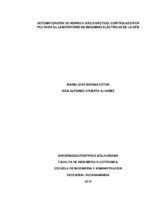Automatización de horno a gas didáctico, controlado por PLC para el laboratorio de máquinas eléctricas de la UPB

View/
Date
2013-08-28xmlui.dri2xhtml.METS-1.0.item-advisor
Villamizar Rincón, Juan Carlos
xmlui.dri2xhtml.METS-1.0.item-type
bacherlorThesis
Citación
Metadata
Show full item recordDocuments PDF
Abstract
En la actualidad hay variedad de hornos para diferentes aplicaciones con especificaciones variadas; se pueden citar varias clases, entre ellos, hornos para joyería, cerámica, de cocina, para fundición, pastelería, tratamientos térmicos especiales, los de tipo eléctrico, industriales y pizzería entre otros, cada uno de los anteriores maneja la variable temperatura. Algunos vienen para ser operados por medio de : electricidad, leña, gas propano, gas natural, resistencias, etc. Es importante resaltar que la temperatura del horno depende del proceso que se esté llevando a cabo, para joyería, orfebrería, cerámica, panadería y pizzería son diferentes y cada uno de ellos tiene requerimientos especiales como máxima temperatura de funcionamiento, tiempo de calentamiento, tiempo de enfriado etc. Algunos hornos operan sin aditamentos especiales, y hay oros que necesitan inyección de aire, oxigeno, inyección de combustibles, dependiendo de la temperatura máxima de operación. Este horno a gas natural, tiene un PLC que le permite al estudiante tener otra opción de controlar la temperatura que se desea obtener en el equipo, desde una estación remota, el abrir y cerrar la electroválvula que permitirá el paso del gas natura, recibir la información que envía el controlador de temperatura, esta señal es de 4 a 20mA, a su vez le llegará la información que envía el sensor de presión, con la misma característica en la señal. Constará de un software desde un PC, donde el usuario pueda interactuar con el equipo, pueda manipular el set point de la temperatura, monitorear las variables de presión y temperatura. Por medio de una gráfica se puede visualizar el comportamiento de la temperatura y/o presión dentro de la cámara. La comunicación ente el PLC y el PC es de tipo serial, donde se puede utilizar los diferentes protocolos existentes como es el RS 485 o el Ethernet. At present there are a variety of furnaces for different applications with varying specifications, we can mentionseveral classes, including jewelry kilns, pottery, cooking, casting, pastries, special heat treatment, the electric type, industry and pizza among others, each of the above handles variable temperature. Some come for surgery by through: electricity, firewood, propane, natural gas, heating, etc. Importantly, oven temperature depends on the process being carried out, for jewelry, silverware, ceramics, bakery and pizzeria are different and each has special requirements as operating temperature, heating time, cooling time, etc. Some operate without any special furnaces, and there are others who need air injection, oxygen, fuel injection, depending on the maximum operating temperature. This natural gas oven has a PLC that allows the student to have another option to control temperature that is to get on the computer from a remote station, the opening and closing solenoid valve allowing the passage of natural gas, receive information sent by the controller temperature, this signal is 4 to 20mA, in turn you will receive information sent by the sensor pressure, with the same characteristic in the signal. Consist of a software from a PC, where Users can interact with the computer, can manipulate the set point temperature, monitor pressure and temperature variables. Through a graphic you can display the temperature behavior and / or pressure within the chamber. Communication between the PLC and the PC is a serial, where you can use various existing protocols such as RS 485 or Ethernet.
Keyword/s
Ingeniería electrónica
Horno de gas - automatización
Horno - construcción
Electricidad - aparatos e instrumentos
Hornos eléctricos
Collections
- Trabajos de grado [6440]

